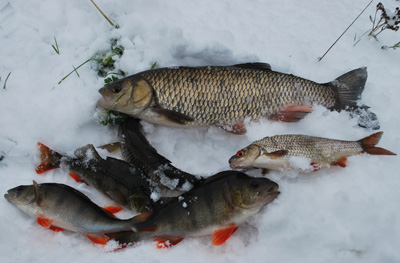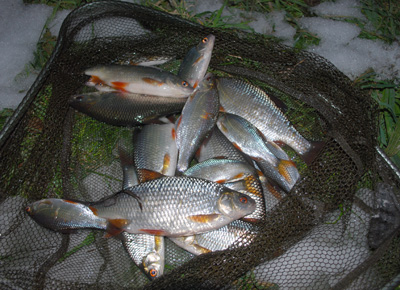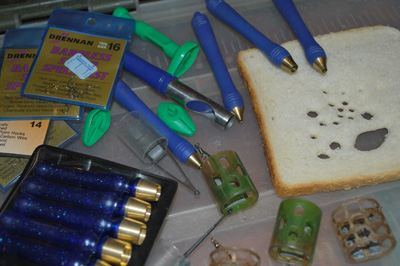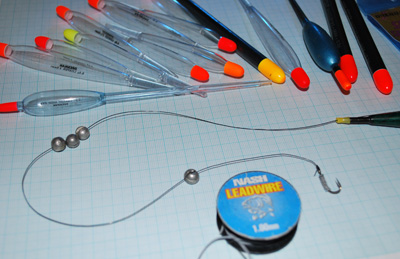There is little other than heavy rain that is likely to keep me away from the riverbank in winter. I still dream that when my precious holiday arrives it is met with mild weather conditions following a sensible amount of rain leaving the river fining down and in perfect trim – but this is, sadly, rarely the case.
The pattern seems to follow that winters are getting harsher and when rain does arrive, it usually means floods! But all is not lost… In fact over the last few seasons I have been amazed to discover that fishing in even the most extreme winter conditions can be surprisingly fruitful.
Fishing can be the most miserable experience imaginable if you do not set out and prepare to survive extreme winter conditions and the key to successful winter fishing is maintaining your core body temperature. I have always found that if you can maintain a stable core body temperature, the rest of your body will stay far more comfortable. In fact, if you get it right, I have been known to regularly fish for hours on end in nothing more than a pair of shorts with little or no discomfort in heavy snow storms. Now I know this is not for everyone, but that is just the way I roll – so hang in there class – it will make sense after a little Biology lesson, I promise!
Preparing for extreme winter weather
In extreme cold weather the body kicks into survival mode and draws heat away from the extremities – that’s fingers and toes to the silly boys at the back not listening! The fine capillaries that supply blood to the surface of the skin contract drawing the warm blood into the body core; this is followed by shivering as the muscle cells desperately contract , encouraging cells to respire to raise the body temperature – result? Utter misery!
Once your body has kicked into this survival response it is very difficult to reverse and nothing will seem more important than returning to the car, getting the heater on and racing home to sit in front of the fire – disaster! The key to keeping warm is to build up layers of insulation that you can add to, or take away, throughout the duration of the session; and in my opinion this is far superior to placing all of your faith on a single all-weather garment.
The foundation to my layering system is a good quality long sleeved thermal vest, t-shirt, jumper, extra large hoody followed by my trusty Barbour jacket. It does not matter one jot how often I replace the wax dressing on my Barbour, I cannot ever claim it to be rainproof – it is however windproof and that is the key.
The next consideration is my neck and head. It is well documented that a large amount of heat ener
gy is lost from this part of the body (as well as important information, or so I am told). I choose to wear two woollen hats and a hooded smock type garment that I can raise over my head to keep draughts out. This garment also acts as a scarf and is trapped beneath my hoodie to ensure as little heat escapes as possible. Get this bit right and you are practically laughing.
A good pair of normal wellies, thermal socks and fingerless mittens covers the rest of my requirements. I particularly like the woollen hybrid gloves that incorporate a mitten top that fits over the fingerless part, thus leaving some sensitivity for knot tying and unhooking fish (See! Note the positive thinking…).
The amazing thing is if you keep your core temperature maintained, your fingers and toes take care of themselves. In fact, after the initial cold feeling has passed, because the body is less inclined to draw the warm blood supply from the extremities, fingers and toes should stay warm and comfortable.
It is really important that you do not allow your body to sweat. Even in the coldest weather the body will get hot when walking any distance. Far better to take a few layers off when exerting yourself only to put them back on later when you are resting. A flask of hot sugary drink and food will also help to keep the core temperature normal and spirits high. It is surprising how in the cold, hunger can often play more heavily on the mind than normal and will not allow you to fish as efficiently as possible.
Finally, it is always advisable to let someone know where you will be fishing and carry a phone in case you get into difficulty. It is surprising how quickly a small track or road can get closed in during a heavy snow storm.
 Fish location
Fish location
The most important thing about winter fishing is maintaining a positive mental attitude. Providing conditions have stayed stable, fish acclimatise to cold water and can be encouraged to feed with vigour. In fact, looking back through my fishing diaries, a great number of red letter days have occurred when conditions have barely exceeded zero degrees.
I have seen a lot written about the fishing becoming hard when snow melt enters the rivers but I have not usually found this to be the case providing the thaw and rise in river levels is not too hasty. In fact, I find if there has been a modest increase of extra flow and colour, this has a positive effect.
The best places to start are deep stretches where the flow is as slow as possible. The usual creases are normally devoid of fish as fish tend to exert as little energy as possible – far better to seek out slack water close to the bank.
Other features that are well worth investigating are beneath tree canopies or just downstream from weirs and races that offer oxygen rich water. I know that it is in stark contrast to the slack water described earlier, but for some reason I have found these areas still hold fish at most times of the year. The good thing is, once you have located fish, they are often closely shoaled together which makes fishing all the easier.
I have a theory that tree canopies hold fish during times of extreme cold as it provides some sanctuary from cormorant predation. Last year in particular saw a number of still waters frozen over. It was not uncommon to see three or four cormorants working the river in a single day as a result, which was very demoralising.
 Tackling up for winter roach fishing
Tackling up for winter roach fishing
I use two rods for feeder fishing; a standard 11ft light feeder rod and a 7ft D.A.M. winkle picker which is superb for detecting those finicky bites in confined swims lined with trees and bushes. I never feel the need to fish ultra light: 4lb reel line and hook link materials ranging from 2 to 3lb seem perfectly adequate if targeting roach, perhaps 4lb straight through if I suspect a good chub is on the cards. The river is usually clear of most of the debris and if playing a fish with care, a larger specimen has every chance of being banked.
The biggest danger when fishing cold water is overfeeding. I find that bread is the most consistent cold water bait, followed by maggots, though I am sure larger baits like lobworms would have their day if I used them.
For free feed I rate liquidised bread very highly and when targeting roach, an aniseed-based additive works surprisingly well and gives me supreme confidence. I prefer to remove the crusts from my liquidised crumb – this is, however, only based on my personal preference, nothing more. To introduce feed there are some superb micro feeders in cage or plain that introduce a pinch or two of loosely compacted crumb near the hook bait. Of course, if feeding in small quantities, it is important to cast as accurately as possible; the last thing you want to do is split a shoal all over the river. Best to have them competing in a relatively confined area not far from cover.
 In many ways punch fishing is seen as an out of date method from a distant era, but I can’t imagine it being beaten in cold water fishing. I use punches ranging from a mere 2mm on a size 18 hook right up to the plastic Drennan punches that land a pear shaped wallop on a size 8 hook. I prepare the bread I will use for punch fishing by placing a slice into the microwave for 20-30 seconds and then placing in a sealed plastic bag. This helps to develop the doughy texture of the bread and enables it to punch cleanly and stay on the hook.
In many ways punch fishing is seen as an out of date method from a distant era, but I can’t imagine it being beaten in cold water fishing. I use punches ranging from a mere 2mm on a size 18 hook right up to the plastic Drennan punches that land a pear shaped wallop on a size 8 hook. I prepare the bread I will use for punch fishing by placing a slice into the microwave for 20-30 seconds and then placing in a sealed plastic bag. This helps to develop the doughy texture of the bread and enables it to punch cleanly and stay on the hook.
The thing I love about fishing for roach in this style is that you always have to think about presentation to keep bites coming. If a sizable shoal is present, anything from lengthening or shortening the hook length, size of hook or bait should keep bites coming – but most importantly, not overfeeding!
Winter chub fishing
In many ways synonymous with cold water conditions chub often offer the best chance of a good day’s fishing in severe wintery weather. Much in common with roach fishing, overfeeding is to be avoided. But there is a problem; sometimes in cold water chub are stubbornly static and require encouragement to feed, whilst on other occasions they can be surprisingly mobile.
I have two main lines of attack: quiver tipping bread crust, or trotting bread flake. If ledgering bread I make my bread mash by sinking a few slices in a landing net and then removing as much excess water as possible before mashing.
The aim is to get a bait that will sink as quickly as possible, whilst still slowly drifting pieces of from the bottom drawing fish towards the baited area. Popped up bread crust seems to be particularly effective in these conditions and if after 20 minutes no bites are forthcoming, a cast further downstream, or indeed closer, may be required to find fish. It is really important to search out the swim thoroughly before upping sticks and moving on.
A word of advice; if making bread mash on a really cold winter’s day, do not allow your hands to come into contact with the freezing cold water. I usually borrow a potato masher and a large plastic serving spoon from the cupboard drawer when the wife’s back is turned. It is surprising how much more accurate it is baiting up with a plastic spoon, and it’s infinitely more comfortable.
There are occasions during periods of extreme cold when it seems as if every chub in the river is feeding with abandon. On such occasions trotting bread is a deadly technique. In contrast to the stodgy bread mash I make for ledgering, I like it to be as fluffy and sloppy as possible so it clouds up as it drifts downstream; my baited hook trotting down amongst the cloud of bread particles.
 There is no finesse required for trotting bread for chub: a 4 swan shot loafer-style float with the bulk shot set at half depth followed by a size 6 hook is the basic set up and I place a BB shot approx. 6 inches from the hook and wind some lead wire along the length of the hook to keep the flake down. Trust me, this drastically improves presentation. A heavy float is essential as it allows for mending line without drifting the off course – something chub are particularly intolerant of.
There is no finesse required for trotting bread for chub: a 4 swan shot loafer-style float with the bulk shot set at half depth followed by a size 6 hook is the basic set up and I place a BB shot approx. 6 inches from the hook and wind some lead wire along the length of the hook to keep the flake down. Trust me, this drastically improves presentation. A heavy float is essential as it allows for mending line without drifting the off course – something chub are particularly intolerant of.
This method accounted for my best ever chub session some years ago with eight chub, including fish weighing 5lb 5oz and 5lb 3oz and this after overnight temperatures dipped to minus five degrees, leaving ice in the margins.
Predator fishing
The thing about winter fishing is that it is difficult to have a definitive plan of action and it is best to have a degree of adaptability. Having ascertained that roach had been shoaled tight up against a feature for a number of days, it had occurred to me that pike would not be too far away from a food larder consisting of bait sized roach.
It was definitely an afterthought, but having a pike rod set up in the back of the van from the previous weekend it was too much temptation not to trot a roach livebait beneath the tree lined canopy of the river. First trot down resulted in a fin perfect pike of 17lb 4oz in the middle of a snow storm!
Escape from winter madness
It is easy to look at our British weather with despair, especially when precious time off corresponds with extreme weather conditions but in reality it just requires a little more planning. I always find the countryside at its most enchanting in the depths of winter and to this day I regret not taking a photograph of the weir ledge encrusted with layers of icicles. For many days that image was impressed upon my mind drawing me back to the river bank.
Better still, those days we have been treated to a dusting of snow; there is something magical about leaving fresh footprints in the snow alongside those of foxes and badgers from the previous evening. But best of all, there is escaping the madness of Christmas shopping and daytime TV. I am certain that for many I am preaching to the converted, but if you needed any persuading that there is any finer place to be but by a river in the depths of winter and you actually get out there and give it a go; then my job is done.
Tight lines and a Merry Christmas every one – whatever the weather throws at us…










